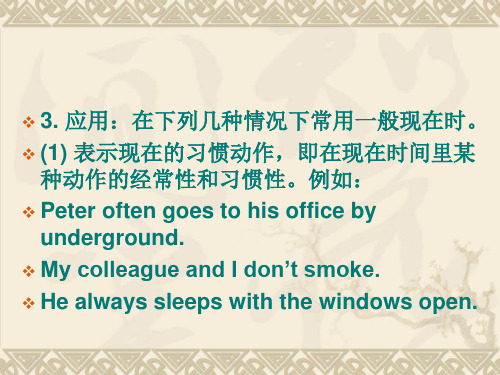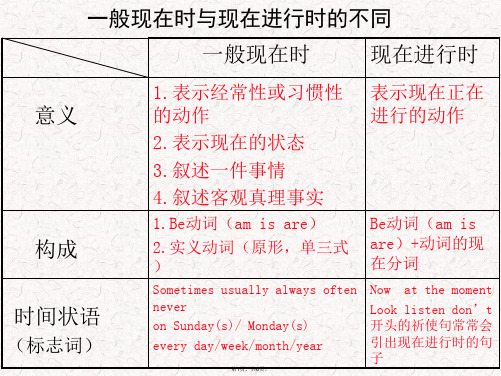最棒的一般现在时与现在进行时讲解导入区分PPT课件
合集下载
一般现在时和现在进行时的区别PPT课件

【时间状语不同】 常与现在进行时连用的时间状语有:now, at the moment; 另外,以Look, Listen 或 Don't ... 等开头的祈使句常常会引出现在进行时的句子。但是, 有时也用一般现在时,要看是表示正在进行的动作还是表示现在的状态。如果表示正在进行的动作就用现在进行时,如果表示现在的状态就用一般现在时。试比较:
动词为双音节或者多音节:最后一个音节为重读音节,以单一元音字母 + 单一辅音字母结尾 辅音字母双写,再加 ing; Beging beginning
以 y 结尾的动词 直接加 ing; Carry carrying Enjoy enjoying
现在进行时
现在进行时的功用
1) 表示说话时正在发生或者进行的动作 Please don’t make so much noise, I’m studying. Let’s get out. It isn’t raining any more. 2) 表示在现在相对较长一段时间内正在进行的动作,但是说话一刻不一定在做的动作 He is building his own house. David is teaching English and learning Chinese in Beijing. 这些动作,在说话时并不一定在发生或进行,而是在包括说话的一刹那在内的一段时间内发生、进行的。
现在进行时是由助动词to be 的现在时 + 现在分词构成现在分词的构成,是在动词原形上加—ing,
动词以单个e 结尾 去掉e, 加 ing Love _lovingArgue _ arguing
动词以 —ee结尾 直接加 ing Agree_ agreeingSee _ seeing
动词为双音节或者多音节:最后一个音节为重读音节,以单一元音字母 + 单一辅音字母结尾 辅音字母双写,再加 ing; Beging beginning
以 y 结尾的动词 直接加 ing; Carry carrying Enjoy enjoying
现在进行时
现在进行时的功用
1) 表示说话时正在发生或者进行的动作 Please don’t make so much noise, I’m studying. Let’s get out. It isn’t raining any more. 2) 表示在现在相对较长一段时间内正在进行的动作,但是说话一刻不一定在做的动作 He is building his own house. David is teaching English and learning Chinese in Beijing. 这些动作,在说话时并不一定在发生或进行,而是在包括说话的一刹那在内的一段时间内发生、进行的。
现在进行时是由助动词to be 的现在时 + 现在分词构成现在分词的构成,是在动词原形上加—ing,
动词以单个e 结尾 去掉e, 加 ing Love _lovingArgue _ arguing
动词以 —ee结尾 直接加 ing Agree_ agreeingSee _ seeing
一般现在时和现在进行时的区别PPT课件

3 不能用进行时表示未来事件
现在进行时只能用于描述当前正在进行的动 作,不能用于描述尚未发生的未来事件。
4 不能用进行时表示心理状态、感觉等
心理状态、感觉等属于持续性的状态,不适 合用进行时来描述。
5 祈使句不能用进行时
祈使句是用于表达命令、请求或建议等,不 适合用于描述正在进行的动作。
6 不能在时间状语中使用will
4 否定形式为主语
5 祈使句形式不能用
+am/is/are+not+现在
进行时
6 表示感觉、心理状
态等不用进行时
分词
祈使句只能用于表达命令、
感觉、心理状态等属于持
在否定句中,需要加上助
请求或建议等,不能用于
续性的状态,不适合用进
动词"am"、"is"或"are",
描述正在进行的动作。
行时来描述。
并在现在分词前加上"not"。
3 时间状语通常是频率
副词或表示时间的名 词或者介词短语
常见的时间状语有"often"、 "always"、"every day"等。
4 动词原形,第三人称单数要加s
在一般现在时的肯定句中,动词原形不变;
5 否定形式为主语+do/does+not+动词
原形
但在第三人称单数时,要将动词变为原形加s。
在否定句中,需要加上助动词"do"或"does",
一般现在时和现在进行时 的区别
了解一般现在时和现在进行时的区别非常重要。本课程将详细介绍这两种时 态的区别以及它们在不同情境下的正确应用。
一般现在时与现在进行时ppt课件

• 4. They __h_a_ve___(have) the same hobby.
• 5. My aunt _lo_o_k_s___(look) after her baby carefully.
• 6. You always __d_o____(do) your homework
well. • 7. I __a_m____(be) ill. I’m staying in bed.
me nice food now.
• 4. What __a_r_e_ you __d_o_in_g_ ( do ) no
w? • 5. Look . They _a_r_e_h_a_v_in_g_( have) an
English lesson .
22
• 7.Look! The girls ________________(dance ) over there • 8.What is our granddaughter doing? • She ________(listen ) to music. • 9. It’s 5 o’clock now. We _____________(have)supper • now
My plane takes off at 9:00 a.m.
The train leaves at three this afternoon.
6
用法5:在时间或条件状语从句中有时用一般现 在时表示将来发生的动作.
主将从现
•主要用在条件状语I’ll call you the moment I arrive in Xi’an.
finish______teach_____fish_______reach_______go__ _____ • do_____have____
初中英语一般现在时精讲对比现在进行时讲解ppt课件

A keep B kept C have kept D keeps
some
寒假来临,不少的高中毕业生和大学 在校生 都选择 去打工 。准备 过一个 充实而 有意义 的寒假 。但是 ,目前 社会上 寒假招 工的陷 阱很多
【用法2】表示客观真理或客观事实。
【例句】 Light travels in a straight line. 光沿直线传播。
A. you are convenient
B. you will be convenient
C. it is convenient for you
D. it will be convenient to you
寒假来临,不少的高中毕业生和大学 在校生 都选择 去打工 。准备 过一个 充实而 有意义 的寒假 。但是 ,目前 社会上 寒假招 工的陷 阱很多
often, usually, seldom, every day等时间状语。
2. 特别注意动词的第三人称单数形式,也就是主谓一致原则。
3.everyday也可用于过去in the past,将来时in the future.
寒假来临,不少的高中毕业生和大学 在校生 都选择 去打工 。准备 过一个 充实而 有意义 的寒假 。但是 ,目前 社会上 寒假招 工的陷 阱很多
寒假来临,不少的高中毕业生和大学 在校生 都选择 去打工 。准备 过一个 充实而 有意义 的寒假 。但是 ,目前 社会上 寒假招 工的陷 阱很多
时态
பைடு நூலகம்时间
寒假来临,不少的高中毕业生和大学 在校生 都选择 去打工 。准备 过一个 充实而 有意义 的寒假 。但是 ,目前 社会上 寒假招 工的陷 阱很多
时间轴 过去 现在 将来
—They have advantages in different aspects. Tom spends as much time reading as John _________.
some
寒假来临,不少的高中毕业生和大学 在校生 都选择 去打工 。准备 过一个 充实而 有意义 的寒假 。但是 ,目前 社会上 寒假招 工的陷 阱很多
【用法2】表示客观真理或客观事实。
【例句】 Light travels in a straight line. 光沿直线传播。
A. you are convenient
B. you will be convenient
C. it is convenient for you
D. it will be convenient to you
寒假来临,不少的高中毕业生和大学 在校生 都选择 去打工 。准备 过一个 充实而 有意义 的寒假 。但是 ,目前 社会上 寒假招 工的陷 阱很多
often, usually, seldom, every day等时间状语。
2. 特别注意动词的第三人称单数形式,也就是主谓一致原则。
3.everyday也可用于过去in the past,将来时in the future.
寒假来临,不少的高中毕业生和大学 在校生 都选择 去打工 。准备 过一个 充实而 有意义 的寒假 。但是 ,目前 社会上 寒假招 工的陷 阱很多
寒假来临,不少的高中毕业生和大学 在校生 都选择 去打工 。准备 过一个 充实而 有意义 的寒假 。但是 ,目前 社会上 寒假招 工的陷 阱很多
时态
பைடு நூலகம்时间
寒假来临,不少的高中毕业生和大学 在校生 都选择 去打工 。准备 过一个 充实而 有意义 的寒假 。但是 ,目前 社会上 寒假招 工的陷 阱很多
时间轴 过去 现在 将来
—They have advantages in different aspects. Tom spends as much time reading as John _________.
一般现在时与现在进行时区别课件ppt

have_h_a_v_i_n_g____ take__t_a_k_i_n_g___ singsi_n_g_i_n_g_____
swimming
getting sitting
walking sit__________ walk__________
differences(不同点):
概念不同: 一般现在时表示主语经常性和习惯性的动作或存在的状态,也表示说话者的能力及自然现象。而现 在进行时表示说话时(瞬间)正在进行的动作,也表示目前或现阶段一直进行的动作。如: She often does her homework in the evening. 她经常在晚上做作业。 She is doing her homework now. 现在她正在做作业。
• 5. I watch TV every day. (改为一般疑问句) • 6. David has a goal. (改为一般疑问句) • 7. We have four lessons.(否定句) • 8. Nancy doesn’t run fast (肯定句)
• 1. 1.The children arreu_n_n_i_n_g______ (
six hours a day.
3. Listen! Joanis__s__i_n_g__i_n_g(sing) in the classroom.sSihnegosften __________ (sing) there.
4. _D_o_e__s_____ your brotherk_n_o_w_______(know)
A:aren't B:do C:don't D:are
用单词正确形式填空
1. My father always c_o__m_e_s_____(come) back from
swimming
getting sitting
walking sit__________ walk__________
differences(不同点):
概念不同: 一般现在时表示主语经常性和习惯性的动作或存在的状态,也表示说话者的能力及自然现象。而现 在进行时表示说话时(瞬间)正在进行的动作,也表示目前或现阶段一直进行的动作。如: She often does her homework in the evening. 她经常在晚上做作业。 She is doing her homework now. 现在她正在做作业。
• 5. I watch TV every day. (改为一般疑问句) • 6. David has a goal. (改为一般疑问句) • 7. We have four lessons.(否定句) • 8. Nancy doesn’t run fast (肯定句)
• 1. 1.The children arreu_n_n_i_n_g______ (
six hours a day.
3. Listen! Joanis__s__i_n_g__i_n_g(sing) in the classroom.sSihnegosften __________ (sing) there.
4. _D_o_e__s_____ your brotherk_n_o_w_______(know)
A:aren't B:do C:don't D:are
用单词正确形式填空
1. My father always c_o__m_e_s_____(come) back from
初中英语 一般现在时与现在进行时的区别PPT课件

__I_s__ Kate _cl_e_a_n_in_g her room? 10
结束语
当你尽了自己的最大努力时,失败也是伟大的, 所以不要放弃,坚持就是正确的。
When You Do Your Best, Failure Is Great, So Don'T Give Up, Stick To The End
第三人称单数形
be动词+ 动词的ing形式(现在分词)
4
1. 一般现在时的时间状语主要有: 2. always, usually, sometimes, never, 3. every day, on Sundays, 4. in the morning/afternoon/evening等 2. 现在进行时的时间状语主要有:
She is doing her homework now. 现在她正在做作业。
3
1. 一般现在时
2. (1) be动词的一般现在时形式:is, am, are
3. (2) 动词have的一般现在时形式:have, has
4. (3) 其他实义动词的一般现在时形式:动词原形
5. 式
2. 现在进行时
2.Many
people
do
______________
(do)sports
in
the park every day. 3.It’s 9:00 am. Wea_r_e___h___a__v__i_n__g__(have) an
English class.
4.Cindy isn’t at home now.
9
1.Susan often watches TV. (用 now 改写句子)
2. Susan _is___wa_t_c_h_in_g__ TV now.
结束语
当你尽了自己的最大努力时,失败也是伟大的, 所以不要放弃,坚持就是正确的。
When You Do Your Best, Failure Is Great, So Don'T Give Up, Stick To The End
第三人称单数形
be动词+ 动词的ing形式(现在分词)
4
1. 一般现在时的时间状语主要有: 2. always, usually, sometimes, never, 3. every day, on Sundays, 4. in the morning/afternoon/evening等 2. 现在进行时的时间状语主要有:
She is doing her homework now. 现在她正在做作业。
3
1. 一般现在时
2. (1) be动词的一般现在时形式:is, am, are
3. (2) 动词have的一般现在时形式:have, has
4. (3) 其他实义动词的一般现在时形式:动词原形
5. 式
2. 现在进行时
2.Many
people
do
______________
(do)sports
in
the park every day. 3.It’s 9:00 am. Wea_r_e___h___a__v__i_n__g__(have) an
English class.
4.Cindy isn’t at home now.
9
1.Susan often watches TV. (用 now 改写句子)
2. Susan _is___wa_t_c_h_in_g__ TV now.
一般现在时和现在进行时的区分ppt课件

leave, start, begin,end, return等
The train leaves the station in 5 minutes. The plane from London arrives at 7: 00.
精选课件
5
1. be 动词的一般现在时的句式:
肯定句:主语+be+表语(n., adj.等)
精选课件
9
2. 实义动词的一般现在时句式:
否定句:主语+don’t+动词原形+其他
e.g. I don’t stay at home on Saturdays.
They don’t have sports every day.
主语+ doesn’t +动词原形+其他
e.g. He doesn’t stay at home on Saturdays.
一般疑问句:Be+主语+表语?
精选课件
6
1. be 动词的一般现在时的句式:
一般疑问句:Be+主语+表语?
e.g.-- Is he a worker?
--Yes, he is./No, he isn’t.
Are you thirteen?
--Are they in the classroom?
精选课件
20
现在进行时的句式
特殊疑问句:对be --Ving 提问要用what. 格式为:what am/is/are +主语+doing.? I am swimming.(对划线部分提问)
精选课件
21
现在进行时的句式
精选课件
22
精选课件
The train leaves the station in 5 minutes. The plane from London arrives at 7: 00.
精选课件
5
1. be 动词的一般现在时的句式:
肯定句:主语+be+表语(n., adj.等)
精选课件
9
2. 实义动词的一般现在时句式:
否定句:主语+don’t+动词原形+其他
e.g. I don’t stay at home on Saturdays.
They don’t have sports every day.
主语+ doesn’t +动词原形+其他
e.g. He doesn’t stay at home on Saturdays.
一般疑问句:Be+主语+表语?
精选课件
6
1. be 动词的一般现在时的句式:
一般疑问句:Be+主语+表语?
e.g.-- Is he a worker?
--Yes, he is./No, he isn’t.
Are you thirteen?
--Are they in the classroom?
精选课件
20
现在进行时的句式
特殊疑问句:对be --Ving 提问要用what. 格式为:what am/is/are +主语+doing.? I am swimming.(对划线部分提问)
精选课件
21
现在进行时的句式
精选课件
22
精选课件
一般现在时和现在进行时的区别 PPT课件

—Are you a teacher? —Yes, I am. / No, I’m not. 2. 行为(实义)动词型(使用动词原 形或动词第三人称单数形式): --- I like English. --- He likes Eng在时的否定句动词形式: 主语+am/is/are not+其它成分. 主语(除第三人称单数) +don’t+动词原形+其它成分. 第三人称单数主语 +doesn't+动词原形+其它成分.
二. 动词构成不同
现在进行时的一般疑问句动词构成
Be动词 ( Am / Is / Are ) +主语+ 动词的现在 分词”+其他成分 ? Are they listening to the radio now ? 他们在听广播吗? Is he wring a letter now ? 他正在写信吗?
They are not in the library. I don’t like swimming.
He doesn't like running. 一般现在时的一般疑问句动词形式: Am/Is/Are+主语+其它成分? Do +主语(除第三人称单数) +动词原形+其它成分? Does+第三人称单数主语+动词原形+其它成分?
2. 以s, x, ch, sh, 或o结尾的动词在词尾加-es,如 dresses, washes, catches, does等.
3. 以辅音字母+y结尾的动词, 先变y为i,再加-es, 如 fly---flies, study--- studies等.
二. 动词构成不同
现在进行时的动词构成
一. 动词构成不同
现在进行时的特殊疑问句动词构成
疑问词+is/am/are +主语+ 动词的现在分词...? What are they listening to now ? What is he doing now ? Where are you going ?
二. 动词构成不同
现在进行时的一般疑问句动词构成
Be动词 ( Am / Is / Are ) +主语+ 动词的现在 分词”+其他成分 ? Are they listening to the radio now ? 他们在听广播吗? Is he wring a letter now ? 他正在写信吗?
They are not in the library. I don’t like swimming.
He doesn't like running. 一般现在时的一般疑问句动词形式: Am/Is/Are+主语+其它成分? Do +主语(除第三人称单数) +动词原形+其它成分? Does+第三人称单数主语+动词原形+其它成分?
2. 以s, x, ch, sh, 或o结尾的动词在词尾加-es,如 dresses, washes, catches, does等.
3. 以辅音字母+y结尾的动词, 先变y为i,再加-es, 如 fly---flies, study--- studies等.
二. 动词构成不同
现在进行时的动词构成
一. 动词构成不同
现在进行时的特殊疑问句动词构成
疑问词+is/am/are +主语+ 动词的现在分词...? What are they listening to now ? What is he doing now ? Where are you going ?
小学英语时态语法:现在进行时、一般现在时时态讲解PPT课件

is jumping
monkey ______ ______ up and down.
Homework: Finish the exercise6.
谢谢大家!
home. 4. What time __do_e_s__ the shop _c_lo_se___ (close)? It _c_lo_se_s_ (close)
at nine o'clock in the evening.
5.Miss Guo __tea_c_he_s_ (teach) us Chinese this term. She ___is___ (be) a very good teacher. She often __ta_lk_s __ (talk) with us after class. Many of us like __ta_lk_in_g _ (talk) with her. Now, she _i_s _ta_lki_ng_ (talk) with Lily.
小学英语时态语法:现在进行时、 一般现在时时态讲解PPT课件
一、现在进行时的定义:表示现在正在进行或发生的动
作 。(句中一般含有now, 单独的look或 listen出现
在句首.)
二、它的结构:be + 动词ing 形式
三、动词加ing的变化规则 1.一般情况下,直接加ing,如:cook-cooking 2.以不发音的e结尾,去e加ing,如:make-making,
改句子 1. Do you often play football after school? (肯定回答)
Yes, we do.
2. I have some books. (改为否定句) I _d_o_n_’t _h_a_v_e_ _a_n_y___ books.
monkey ______ ______ up and down.
Homework: Finish the exercise6.
谢谢大家!
home. 4. What time __do_e_s__ the shop _c_lo_se___ (close)? It _c_lo_se_s_ (close)
at nine o'clock in the evening.
5.Miss Guo __tea_c_he_s_ (teach) us Chinese this term. She ___is___ (be) a very good teacher. She often __ta_lk_s __ (talk) with us after class. Many of us like __ta_lk_in_g _ (talk) with her. Now, she _i_s _ta_lki_ng_ (talk) with Lily.
小学英语时态语法:现在进行时、 一般现在时时态讲解PPT课件
一、现在进行时的定义:表示现在正在进行或发生的动
作 。(句中一般含有now, 单独的look或 listen出现
在句首.)
二、它的结构:be + 动词ing 形式
三、动词加ing的变化规则 1.一般情况下,直接加ing,如:cook-cooking 2.以不发音的e结尾,去e加ing,如:make-making,
改句子 1. Do you often play football after school? (肯定回答)
Yes, we do.
2. I have some books. (改为否定句) I _d_o_n_’t _h_a_v_e_ _a_n_y___ books.
一般现在时和现在进行时详解及比较ppt课件

❖ She’s always borrowing money and forgetting to pay me back.
为深入学习习近平新时代中国特色社 会主义 思想和 党的十 九大精 神,贯彻 全国教 育大会 精神,充 分发挥 中小学 图书室 育人功 能
❖ 3)表示按计划安排近期内即将发生的动作, 即用现在进行时表示将来的用法。例如:
[巩固练习]
❖ 1. I’ll tell her what you have done for Tom
when Mary
.
❖
A. is returning
B. will return
❖
C. returns D. is going to return
❖ 2. I really feel bored because the naughty
❖ ① My parents
in Hong Kong. They
were born there and have never lived
anywhere else. (2009 天津)
❖ A. live
B. lived
❖ C. were living
D. will live
为深入学习习近平新时代中国特色社 会主义 思想和 党的十 九大精 神,贯彻 全国教 育大会 精神,充 分发挥 中小学 图书室 育人功 能
❖ We are meeting him after the performance.
❖ Mr. John is leaving China in a few weeks. ❖ 补给站:用现在进行时表示将来时间,在句
中或上下文通常有表示将来时间的状语或其 他依据,否则意义便会含糊不清。
为深入学习习近平新时代中国特色社 会主义 思想和 党的十 九大精 神,贯彻 全国教 育大会 精神,充 分发挥 中小学 图书室 育人功 能
❖ 3)表示按计划安排近期内即将发生的动作, 即用现在进行时表示将来的用法。例如:
[巩固练习]
❖ 1. I’ll tell her what you have done for Tom
when Mary
.
❖
A. is returning
B. will return
❖
C. returns D. is going to return
❖ 2. I really feel bored because the naughty
❖ ① My parents
in Hong Kong. They
were born there and have never lived
anywhere else. (2009 天津)
❖ A. live
B. lived
❖ C. were living
D. will live
为深入学习习近平新时代中国特色社 会主义 思想和 党的十 九大精 神,贯彻 全国教 育大会 精神,充 分发挥 中小学 图书室 育人功 能
❖ We are meeting him after the performance.
❖ Mr. John is leaving China in a few weeks. ❖ 补给站:用现在进行时表示将来时间,在句
中或上下文通常有表示将来时间的状语或其 他依据,否则意义便会含糊不清。
1初一英语《一般现在时和现在进行时的区别》PPT课件

often __________ (sing) there. 4. ________your brother __________(speak) Chinese? 5. Where __________ you __________ (have) lunch every
day? 6. The girl __________(like) wearing a skirt. Look! She
A. take B. takes C. are taking
19. That elephant two big ears.
A. have B. has C. are D is
20. My uncle
clothes every evening.
A washes B. is washing C. wash
3. Jack usually
grandpa very much. A. miss B. misses C: missing
4. He _______ his homework now. A: doing B. is doing C. does
5. Lily _________ the piano now. A: playing B plays C is playing
21. I __________ a letter in the mail box now
A putting B am putting C put
22. I ________ a fairy tale now.
A read B am reading C reads
第6页,共6页。
第1页,共6页。
Now at the moment
Look listen don’t 开头的祈使句常常会 引出现在进行时的句 子
day? 6. The girl __________(like) wearing a skirt. Look! She
A. take B. takes C. are taking
19. That elephant two big ears.
A. have B. has C. are D is
20. My uncle
clothes every evening.
A washes B. is washing C. wash
3. Jack usually
grandpa very much. A. miss B. misses C: missing
4. He _______ his homework now. A: doing B. is doing C. does
5. Lily _________ the piano now. A: playing B plays C is playing
21. I __________ a letter in the mail box now
A putting B am putting C put
22. I ________ a fairy tale now.
A read B am reading C reads
第6页,共6页。
第1页,共6页。
Now at the moment
Look listen don’t 开头的祈使句常常会 引出现在进行时的句 子
- 1、下载文档前请自行甄别文档内容的完整性,平台不提供额外的编辑、内容补充、找答案等附加服务。
- 2、"仅部分预览"的文档,不可在线预览部分如存在完整性等问题,可反馈申请退款(可完整预览的文档不适用该条件!)。
- 3、如文档侵犯您的权益,请联系客服反馈,我们会尽快为您处理(人工客服工作时间:9:00-18:30)。
1.一般情况 + s like → likes 2. 以s,x,sh,ch结尾的动词 + es
finish → finishes
1.一般情况 +ing do → doing 2.以不发音字母e结尾 去e加ing
take → taking
3. 以辅音字母加y结尾 变y为i, 再加es 3.以重读闭音节结尾,末尾只有一 个辅音字母
B. is crying
C. cries
5.We ___A__ music and often _____ to music.
A. like/ listen B. likes/ listens C. like/ are listening
.
10
6. It’s eight o’clock. The studentsD_____ an English class.
picnic → picnicking
.
9
当堂检测:
1. —— What is your mother doing now?
—— She ___B____some clothes.
A.washes B. is washing
C. wash
2.Mrs Miller __C___ the windows every day.
A. is cleaning B. clean C. cleans
3. Look, they ____C_____ basketball over there.
A.are
B.play
C.are playing
4. Listen! The baby _B____ in the next room.
A. crying
A. get
B. gets
C. getting
9.On Sunday he sometimesຫໍສະໝຸດ __C___ his clothes
and sometimes _____ some shopping.
A. wash/ do B. is washing/ is doing C. washes/ does
clean → cleaning
.
3
eight o'clock in the evening
I always watch TV in the evening on weekends.
I am watching TV now.
watch → watching
.
4
I sometimes read books on Look, I am reading a
Let's talk about my life.
.
1
I usually take a shower at about 8:00.
ListenI, am taking a shower now
take →taking
.
2
I never clean the room.
Look, I am cleaning the room now
A. have B. having C. is having D. are having
7. Don’t talk here. Grandparents _A____.
A. is sleeping B. are sleeping C. sleeping D. sleep
8.She __B___ up at six in the morning.
3. 循环的时间:on Mondays 每周一
on weekends 在周末
.
in the mornings 每天上午
on school days 在上学期间
7
现在进行时
当活动或动作是现在(谈话瞬间)正在进行或发生
的,如他们 正在打球,此时用现在进行时。
结构: 主语+be+动词ing+其他 eg: I am listening to music now
the weekend.
book now.
read → reading
.
5
现在思考一下
• 同样的一件事情使用了两种表达,这是为 什么?
.
6
一般现在时
当活动或动作是经常性、习惯性发生的,如每天早
上6点起床,此时用一般现在时。
结构: 主语+be动词/情态动词结构/实义动词+其他 eg: I am a boy.
I can play soccer well.
I like to watch the soccer game.
标志词 1.every系列:
• every 2.频率副词:
day/week/month/year/morning... always , usually, often, sometimes,never...
study → studies 4.以o结尾的动词 + es
go → goes do → does
双写这个辅音字母,再加ing
swim → swimming get → getting run → running shop → shopping
特殊变化: have → has
特殊变化: die → dying lie → lying
10. Look! The twins ___A__ new sweaters.
A. are wearing B. wearing C. are wear D. is wearing
.
11
Have a try:
1. Listen! Joan __is_s_i_ng_i_n_g__(sing) in the classroom. She often ____si_n_gs____ (sing) there . 2. ___D_o_e_s__your brother ____s_p_ea_k___(speak) Chinese? 3. Where _____d_o____ you ____h_a_v_e___ (have) lunch every day? 4. The girl ____d_oe_s_n_'t_l_ik_e__(not like) wearing a skirt. 5. We __h_a_ve__ (have) PE three times a week. 6. There __a_re___ (be) twelve months a year. 7. ----Where is Lily? ---- She__i_s_ta_l_ki_n_g_ (talk) to her sister, Lucy.
标志词 1.时间状语: now , right now 目前,此时
at the moment 此刻、现在 , these days 这些天 , this week 本周
2.句首引起注意的词: Look, Listen,
It's+时间 引导的具体时间
where引导的问句
.
8
祈使句
动词形式变化
一般现在时: 第三人称单数变化 现在进行时: 动词ing变化
